Creating a new form of social participation by alter ego robots A New Form of Social Participation OriHime and NIN_NIN Expanding “Mobility of the Mind
11/7/25
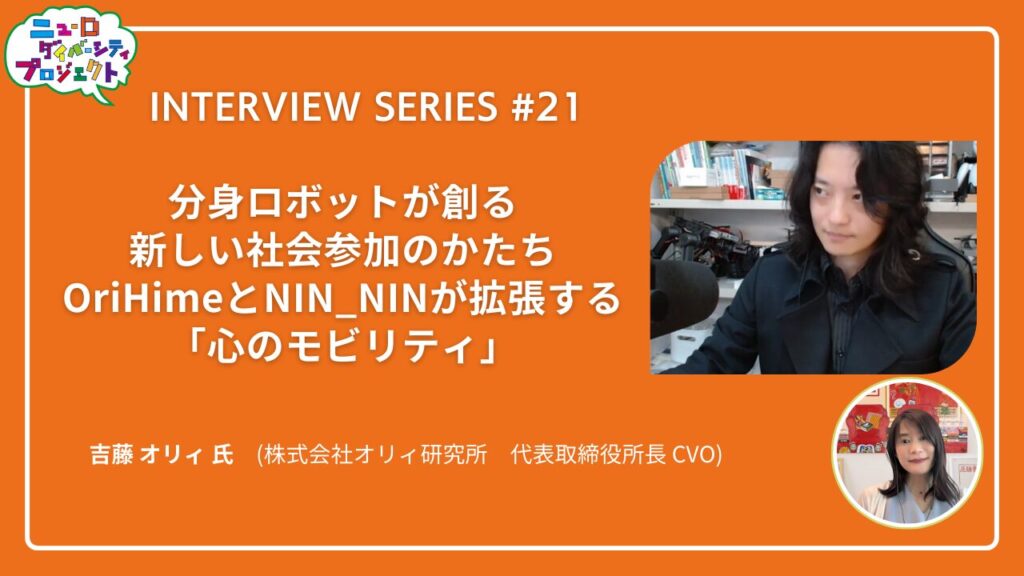
The Neurodiversity Project, sponsored by B Lab, aims to realize a society in which everyone can exercise their abilities in their own way, respecting the diversity of the brain and nervous system. Introduced in this Neurodiversity Project interview series is the initiative of OryLab Inc. Ory Yoshifuji (▲Picture 1▲), President and CVO of OryLab Inc., who developed the remotely operated alter ego robot “OriHime,” which allows users to share the feeling of “being there,” was interviewed by Nanako Ishido (▲Picture 2▲), Director of B Lab, about the background, specific details, and future prospects of this initiative.

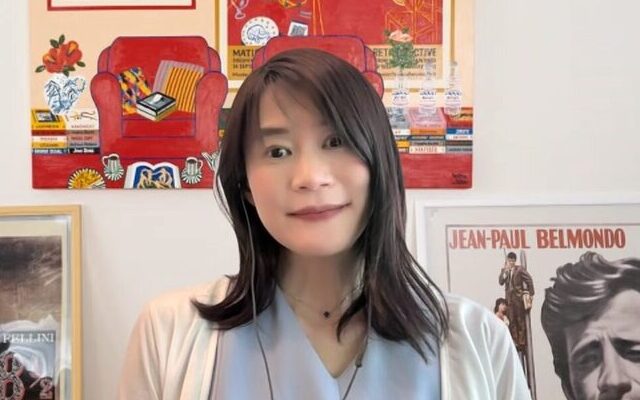
Remote-controlled to Share the Sensation of “Being There
OriHime”, an alter ego robot that can be remotely controlled to share the sensation of being “in the moment
Ishido: “For this edition of the Neurodiversity Project interview series, I would like to talk to Mr. Ory Yoshifuji of Ory Laboratory. What kind of initiatives are you working on at Ory Laboratory in relation to neurodiversity?
Mr. Ory: “At Ory Laboratory, we are making a remote-controlled robot called OriHime. This is a robot that can be remotely controlled as if it were one’s own alter ego by people in wheelchairs, people with ALS, the mentally disabled, and others who for whatever reason are unable to leave their homes. We believe that this robot will enable people who have difficulty leaving their homes to work outside, and we are working on a demonstration experiment. We operate the “alter-ego robot café” near Shin-Nihonbashi Station, Kodenmacho Station, and Kanda Station. We started about 4 years ago and now have 60,000 customers a year. The key point is that the robots working here are operated not by AI but by people remotely. (▲Photo 3▲)

I myself used to be so weak that I could hardly attend school for about three and a half years, and I kept wondering how I could participate in society. How can we eliminate loneliness, that is my research theme. As one of the ways to eliminate loneliness, I first focused on developing a wheelchair so that people with disabilities could go out and interact with others. In fact, about 20 years ago, when I was a student at an industrial high school, I was working with my manufacturing mentors and senior students on research to create a wheelchair that would not tilt and could climb steps.
However, there are people who have difficulty getting around even with a wheelchair. So I wondered if it would be possible to create a “wheelchair for the mind,” and I presented a robot called “OriHime. This was more than 10 years ago when I was a university student. I wanted to make it possible for people who were hospitalized and unable to go home or attend school to operate the robot remotely. OriHime” is equipped with a camera, microphone, and speakers, so we thought it would be possible to create “another person’s body” by having it take over for me.
The impetus for developing “OriHime” goes back to when I was a student at Waseda University. At that time, attendance was important for earning credits, and there were attendance points. However, this could only be received if you brought your body. So I said, ‘If you use Skype, you can listen to the professor’s lecture and you can see my face. Please let me attend the class with this,’ but they did not approve it. No matter how good my score was on the exam, I would not receive attendance points and would not be able to earn credits. I felt uncomfortable because I was physically weak and built a wheelchair when I was in technical high school, for which I received a recommendation and was admitted to Waseda University, but I was not accepted. Then I thought thoroughly about ‘what is a body’ and made a robot with my face. (▲Picture 4▲)

Losing physical freedom, becoming bedridden
Create “options for life beyond that” with technology
Ishido: “That’s a great dynamic.
Mr. Ory: At first it was hard for me to accept, but then I thought about it calmly and realized that even if I couldn’t leave my house, I could walk around outside with a robot. If I spread my alter ego robot around the world, I would be able to leave the house even if I am bedridden. Basically, the world is designed for people who can move their bodies, but if there were robots around the world that could be controlled by brain waves, they could go anywhere, even to the other side of the world, in an instant, even while in Japan. (▲Photo 5▲)
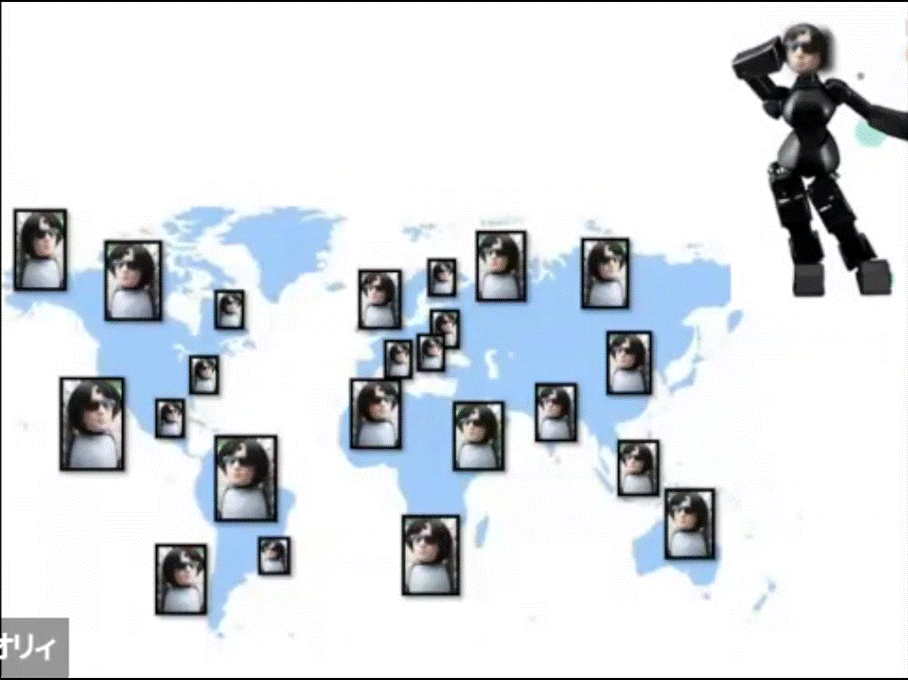
I had a bedridden best friend who was my secretary. (▲Photo 6▲)
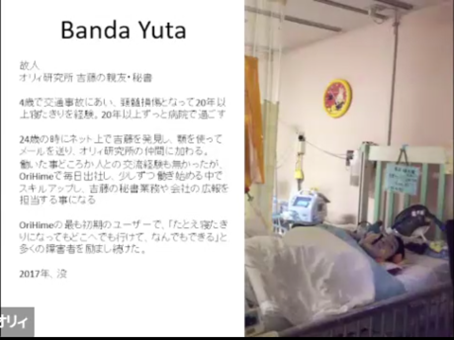
I have many omissions and omissions, and I am so forgetful that I am clearly more deficient than most people, so I wondered if my friend could make him a secretary. We thought that if he, a bedridden man, could work properly as a secretary, we could create a world where people from all walks of life could work. We called him not a handicapped person but a “bedridden senior,” and we worked with him to create “OriHime. Even if he became bedridden, we continued to work together to create a world where “there is beyond” and “we can go beyond being bedridden. This good friend of mine has passed away, but I have done various activities with him.
About 40% of the staff have never worked at the café before, but I feel that we are providing very good customer service. If you look at the reviews of the “Cafe” on Google Maps, you will see that people are praising us by name, saying, “Mr. XX’s customer service was good. We are proud of that. We believe that we are not “making a café,” but rather, we are making “a place for the bedridden. To do that, we need education. We also need new technology. We are developing various technologies, such as eye tracking devices, and we are creating “options beyond the bedridden,” thinking that one day we, too, will be bedridden.
As a new technology, we have created a system called “OriHime eye” that enables eye gaze input. (Photo 7)
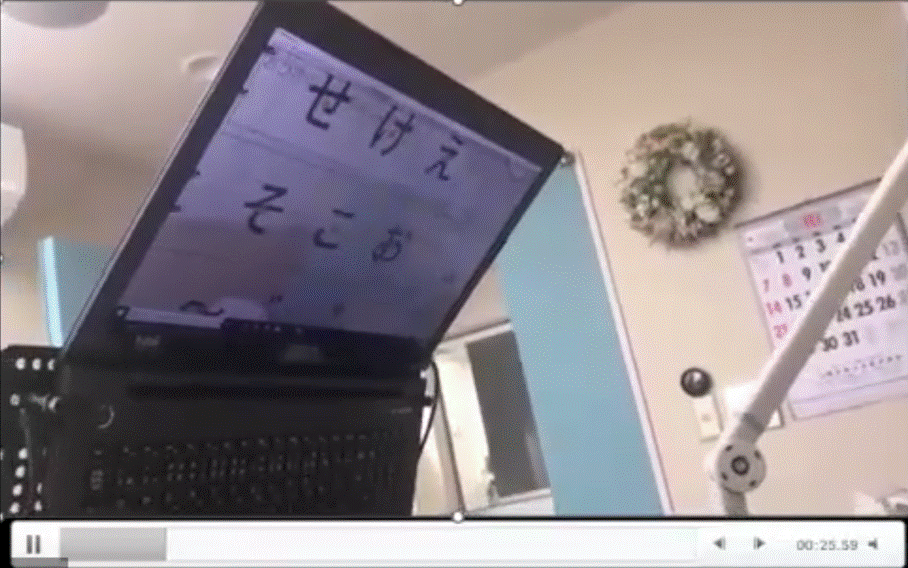
This is an internationally patented technology that allows users to operate a computer using only their eyes. Using this technology, an ALS patient named Hiroyuki Sakaki painted a picture. (Photo 8)
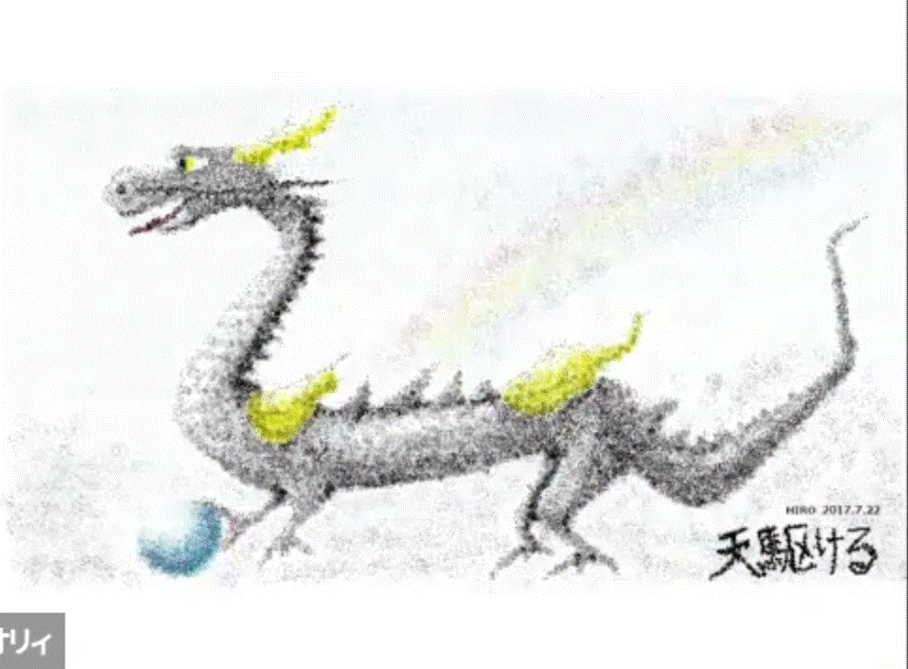
I developed only a computer input technology and device, a mouse so to speak. He used it to express himself in a new way. We too will be bedridden someday. Mr. Sakaki could hardly move his body and could not make facial expressions, but his consciousness was clear. Using the eye input system, he could express his feelings as text in almost real time, and the robot could be operated remotely. Although Mr. Sakaki had already passed away, he was able to do these things by utilizing “OriHime eye.
Now, bedridden people with ALS in Japan can also use this system to communicate with their families and have conversations with synthetic voices. The possibilities are gradually expanding, such as building good relationships with other patients in the hospital, posting their pictures on Facebook, and drawing pictures as a hobby. We are moving these things forward a little bit, and this is what we are working on now,” he said.
Participation in the human activity of society is the most effective way to
is the most effective way to “relieve loneliness.
Ishido: “It brings new colors to life. I felt it was such a technology.
What I always realize as I work on the Neurodiversity Project is how I myself have been under the spell of the “conventional norm. I believe that the essence of the Neurodiversity Project is to create the “norm of the future.
In that sense, I felt that you has been questioning existing common sense and presenting a new normal to society for a long time.
Mr. Ory: “In addition to creating the norm, we have focused on thinking deeply about what we want to do. Technology is only a tool. Even patented technology depends on how it is used. I think it is very important to think about what the people who use the technology want to do with it.
Of course, ‘what you want to do’ itself can be born from technology. My ally, Mr. Masatane Muto, was diagnosed with ALS in his 20s, and more than 10 years have passed since then. He writes proposals using only eye input, designs clothing, composes music, and DJs. There is no point in having the desire to do something and then giving up on it. By putting his “desire to do it” into words, he is able to think about how to make it happen. I feel that through the repetition of this process, the norm in the world will change. (Photo 9)
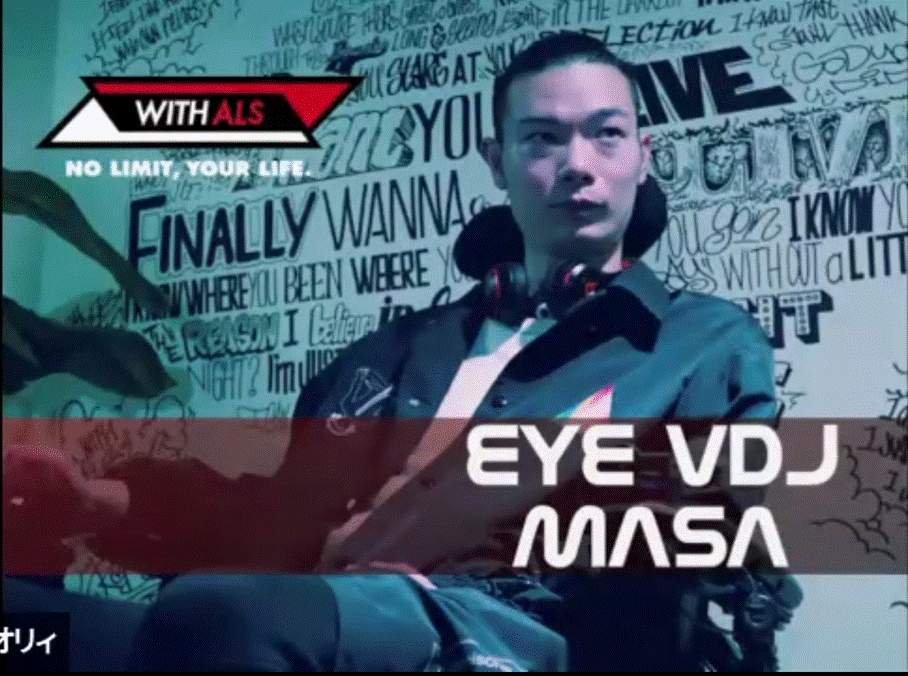
Ishido: “With the advent of generative AI, we are entering an era in which many things are being replaced by AI. What is being questioned now more than ever is the will of human beings, ‘What do we value and how do we want to live our lives? Human beings have continued to create new technologies based on their wish to have something like this.
Therefore, as I listened to Mr. Ory’s talk, I was reminded that the most important thing in this time of accelerating technological evolution is the human will to “do what you want to do.
Now that we have talked about this, I would like to ask you a few questions. First, I would like to talk about “social participation.
Our Neurodiversity Project is also working to create opportunities for those who have had difficulty participating in society by utilizing technology to expand their individuality and adjust their environment. What does “participating in society” mean to you?
Also, please share your thoughts on how you view the nature of social participation.”
Mr. Ory: “I used to have an experience where I couldn’t say ‘thank you’ to people because I said too much. I stayed home all the time because my mother quit her job to take care of me and my friends brought their prints home. Even though I was out of school, my school teachers never gave up and came to my house. I am insanely grateful for that. However, what I was feeling at that time, though it may seem extravagant, was the feeling that if you say ‘thank you’ too much, you will not be able to say ‘thank you’ enough. In other words, it is hard to keep getting help. Of course, we need help. But there is a difference between needing help and wanting to continue to be helped.
I still speak to my parents in honorifics, a remnant of that time. I can no longer say “Arigato” (thank you), but “Arigato gozaimasu” (thank you). When you are in a position to ask someone for a favor, your words become honorific, and eventually you can no longer say “Thank you,” and it changes to “I’m sorry all the time. Eventually, you can no longer say, “Thank you,” and it becomes, “I’m always sorry,” which becomes, “I’m sorry. Please leave me alone. Sometimes I would think, ‘Wouldn’t they be happier without me, including my family, classmates, and friends? This is the worst situation, and I would think, ‘If I think rationally, it would be better if I am not here. Then I would think, ‘What can I do to make myself disappear?
Because of that period of time, I believe that saying ‘thank you’ is not a matter of course, but probably can be said because we can share that feeling with each other. I believe that those who continue to be helped and those who continue to say ‘thank you’ cannot say ‘thank you’ indefinitely.
The reason I am working with patients with intractable diseases such as ALS is because I can relate to these feelings and awareness. When I wonder if it is OK for me to wear a respirator, or if it is OK for me to live, I wonder if there is anything I can do to help them. I felt that if I did not feel that I was contributing to someone, I would cease to be a human being.
I also did AI robotics research when I was in the college of technology, and I also did research on using VR to create missions in games. I have done a variety of research, but I felt that being needed by others and participating in the human activity of society was the most effective way to relieve loneliness, so I am working on research in that area.
Shoulder-riding Robot “NIN_NIN” Connects People to People
Enabling Body Sharing
Ishido: “How do you feel the meaning of your existence? I also feel that this is the very hope for life itself. From the perspective of a society in which we can share “thank you” with each other, the robot “NIN_NIN” based on the concept of “body sharing,” in which we share our bodily functions with others, as you mentioned before, is a perfect example of such a society. Could you please tell us about this “NIN_NIN” project?
Mr. Ory: “We are developing this project on an experimental basis near the ‘alter-ego robot cafe’ in Nihonbashi. This project was started by a group of friends, including Tomohiro Sawada, a friend of mine from a major advertising agency who conceived of “Yuruspo,” and product designer Kosuke Takahashi. How did you develop “NIN_NIN”? Even after creating “OriHime” and making it possible to travel, there was a problem that it was difficult to carry “OriHime” around with you. So we wondered if we could make it worthwhile to have people take it with them and be there with them, so to speak. (Photo 10)
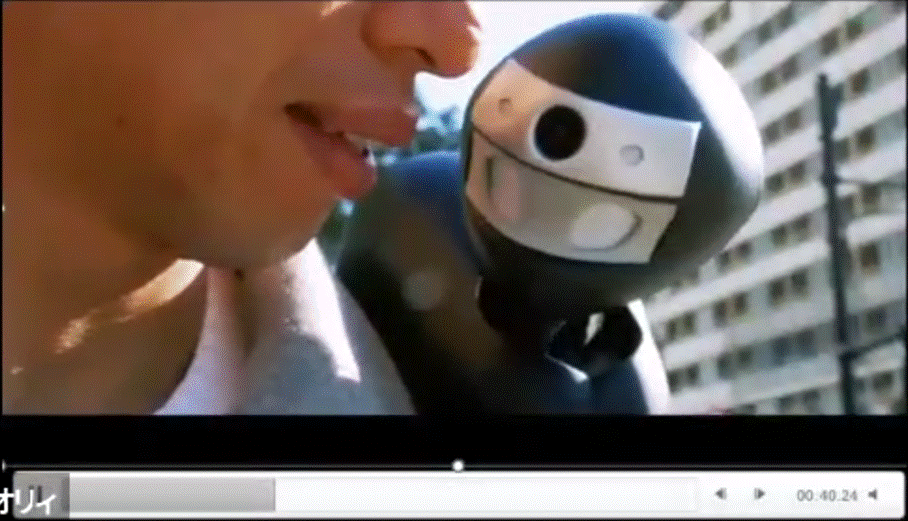
For example, it would be very helpful to have someone beside a person who is blind. We thought what if two people, one who is visually impaired but can move his/her body and walk outside, and the other who can see and speak but cannot leave his/her home due to physical disabilities, complemented each other in what they can do. The concept is called “body sharing,” and the goal is that by sharing their bodies, they can complement each other and help each other do the things they could not do.
We are currently working on a project in Nihonbashi as an experimental “OriHime Guided Tour” for use in the tourism field. We are starting a service to guide and interpret for foreign tourists in the city. Eventually, we too will not be able to leave our homes. Of course, we may leave it to AI, but I believe that “NIN_NIN” will provide an opportunity for, for example, nieces and nephews to interact with their grandfathers and grandmothers. NIN_NIN” connects people to people. I designed it as a ninja to give the impression of a ninja, based on the concept of ‘people to people.
Ishido: “The concept, naming, and design are wonderful.
Mr. Ory: “We are not mass producing “NIN_NIN” right now, so it is still a prototype. Even so, we are using ‘OriHime’ riding on your shoulder to convey the charms of Nihonbashi to foreign tourists around Nihonbashi and over 40,000 of the 60,000 people a year who visit the Robot Café, such as teaching them how to visit shrines and temples. We are now offering this experience, so we would be happy if you could come and visit us. (Photo 11)
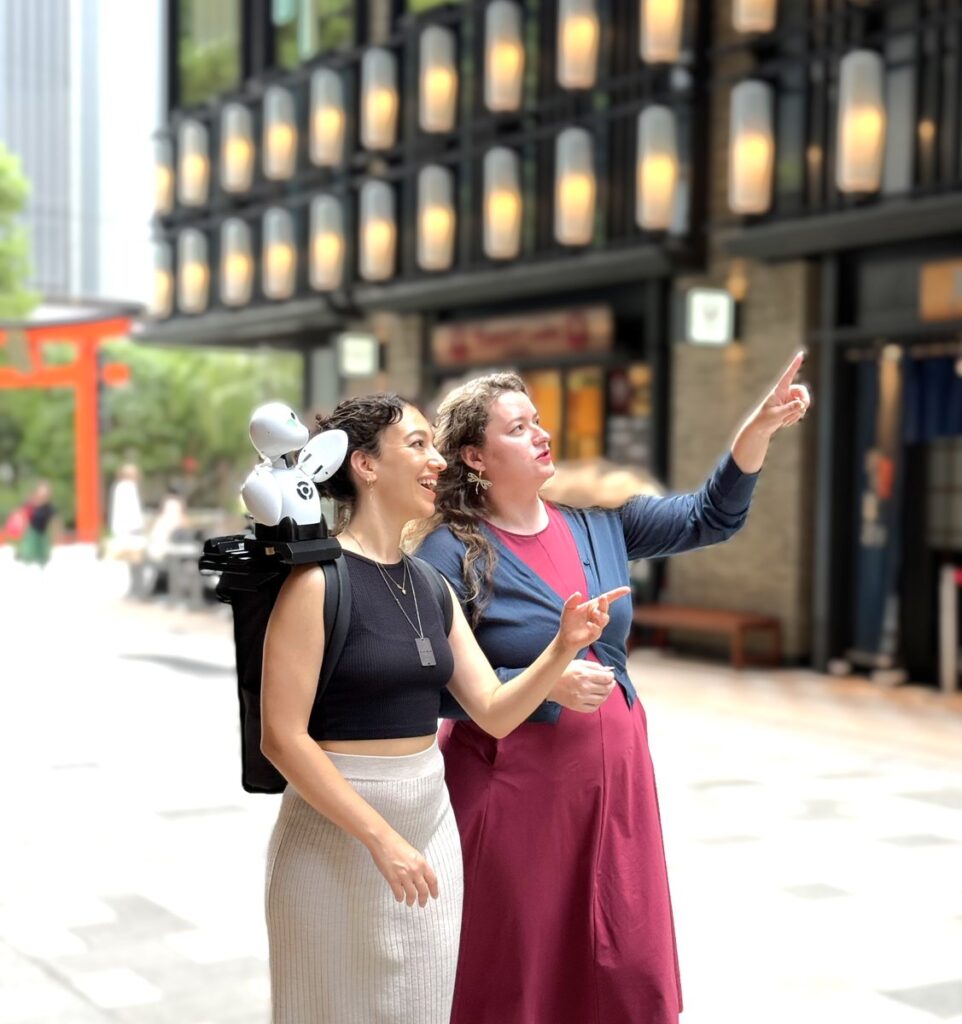
Ishido: “I felt that this technology is very meaningful not only for bedridden people, but also for those who live overseas and cannot easily travel to Japan, for example. Furthermore, as I mentioned earlier, the fact that it can be used for daily communication among relatives is very attractive.
Mr. Ory: “As a matter of fact, we’ve even had an inquiry from a father of a family who wants to rent a room when he can’t take his family to an amusement park,” he said.
Ishido: “When I took “OriHime” to a museum, people who could come if they wanted to were carrying “OriHime” on their shoulders, and I suddenly wondered what the admission fee would be in this case and whether perhaps we need to design a new social system. I realized that the expansion of this kind of technology will greatly expand the range of human activities and options. Technology that was originally created to solve the problems of people with difficulties will result in new possibilities for many people. OriHime is a perfect example of this.
Mr. Ory: “OriHime” has a large “OriHime” on its shoulder, and this figure is surprisingly well received by people overseas, so we are thinking of creating it by first working backward from the market targeting foreign tourists.
Ishido: “Mr. Ory, who appeared in the first presentation material, exists in various parts of the world. That is indeed an alter ego. The idea of altering one’s body or merging and sharing one’s body with others is very interesting, and I feel that it will become a new concept that symbolizes the coming era. What kind of existence is the “body” for you?
Mr. Ory: “There are many ways of thinking about that, and of course there will be objections, but I think of it as mobility; I think of it as one vehicle, and when I was lonely and my mind was screaming, I wondered why I only had one body. I thought that if I had another body, I would be able to use it to make new friends, to study, to take my place in the world, and to make various important encounters in life.
A wheelchair is a means of transporting the body, but we wondered if we could create mobility to transport the mind for people with ALS, who are unable to move their bodies by any means.
The clue was VR and online gaming. I have had several friends who are shut-ins, and they all play VR and online games. And they have different personalities there. They have roles and they are dependent on you. So in a way, I also think that the body is a medium. And this body is given to us by our parents. So is the name. When I think that the body, name, and existence are all given to me by my parents, I feel that the character in the online game is not me, but a child. I take the time to have character meetings. I also give it a name. It is me.
It is me who gets annoyed when my online character is made fun of by everyone else. So even if I create another body, I am fully capable of thinking of it as myself. When I thought about this, I thought that it would be possible to create a kind of body as a mobility of the mind,” he said.
Ishido: “You mentioned that you wanted to create a wheelchair of the mind, but I was listening to your story with the feeling that your body is also a wheelchair of the mind, and that by expanding it, you could create a new medium to carry various minds. On the other hand, as your episode of not being recognized as “present” at a school when a robot that imitated his face was placed there, it may take some time for society to accept this new way of being, where the robot is not physically there even though it is present. So, what part of society needs to change, and in what way, in order for society to implement what you are aiming for through “OriHime”?
Mr. Ory: “I have been thinking about this a lot, but first of all, I don’t think that the world will suddenly and drastically change. Unless there is a major breakthrough, something so big that the world cannot survive without it, it will not change all at once. On the other hand, I believe that there will be other changes. It is possible that the world will gradually increase the number of options available to people.
I used to love anime, but even in that otaku culture, the word otaku used to be almost synonymous with the word “weirdo,” but now it is also a compliment. I think the world’s response to people in wheelchairs and people with disabilities has also gradually changed like a slope, albeit in various waves.
Therefore, rather than a world that forces everyone to rock climb in an attempt to bring about a major social change, I believe it is more important to create a slope that allows all kinds of people to climb slowly. It will take time, but it is important to create something that will be accepted by society. The “alter-ego robot café” is an example of such an experiment, but I believe that by breaking through each of these questions one by one, such as “Will customers talk to people who look like robots? I believe that we can gradually create something that will be accepted by the public.
In the future, with just a gaze input
We can make a robot that can take care of itself.
Ishido: “Mr. Ory jumped in bravely like the first penguin and expanded the circle of sympathy, saying, ‘This kind of society may be possible. I felt that there would be a great social change ahead.
I also strongly sympathize with the point that the perception of disability is changing. For example, just as people with poor eyesight are no longer called “handicapped” because of the advent of eyeglasses, I see the possibility of a future in which what have been considered “disabilities” will no longer be disabilities due to the evolution of technology and society.
I also believe that the point that ‘every person will one day become a person with a disability’ is also true. In the future, how should we rethink the way we perceive disability, or the term and concept of disability? What are your thoughts on this?
Mr. Ory: “I have a theory there as well, and I believe that there is a disconnect between having a disability and having a disability. For many people, perhaps the disability itself exists. A disability is ‘something you can’t do on your own. If we are unable to do something in our daily lives, or if we want to do something so badly that we cannot do it, then a disability exists. For example, if we cannot fly even though we are dying to do so, a disability exists. However, we live in a world now where we are not troubled even if we cannot fly, so this is just the way it is.
We see a disability as the inability to do what one wants to do, so as long as people of all walks of life have something they ‘want to do’ or ‘have to do’, there should be a way to solve that problem. Many people do not have mobility difficulties now, but it is possible that they will in the future. Then, those who are already facing the disability of mobility difficulties at this point are the “seniors” so to speak. I believe that bedridden people can be thought of as “bedridden seniors. By thinking about what we can do with these seniors and exploring solutions together, I believe we can create options for solutions.
Ishido: “Certainly, if you go to an English-speaking country without being able to speak English, you could say that you have a kind of communication disability. Ultimately, depending on how we design the environment, a disability may cease to be a disability, or conversely, something that was not a disability may appear as a disability. In other words, it is a matter of the state of society and how we perceive it.
I am sure that there have been many moments when “what could not be done became possible” through the technology developed by Mr. Ory.
Can you tell us about any particularly memorable episodes or realizations, including your work with people with ALS?”.
Mr. Ory: “Here’s an episode from when we built the big OriHime: Hiroo Okabe, an ALS patient who passed away, who was also my benefactor and former president of the ALS Association, operated the big OriHime with his gaze input. It is now possible for me to do physical work, such as delivering hot coffee to me nearby or picking up my helper at the door. This makes me think that in the future I will be able to take care of myself as well. I want to make it. It is a great feeling to know that I may not have to give up on something that I had given up on. (▲Photo 12▲)
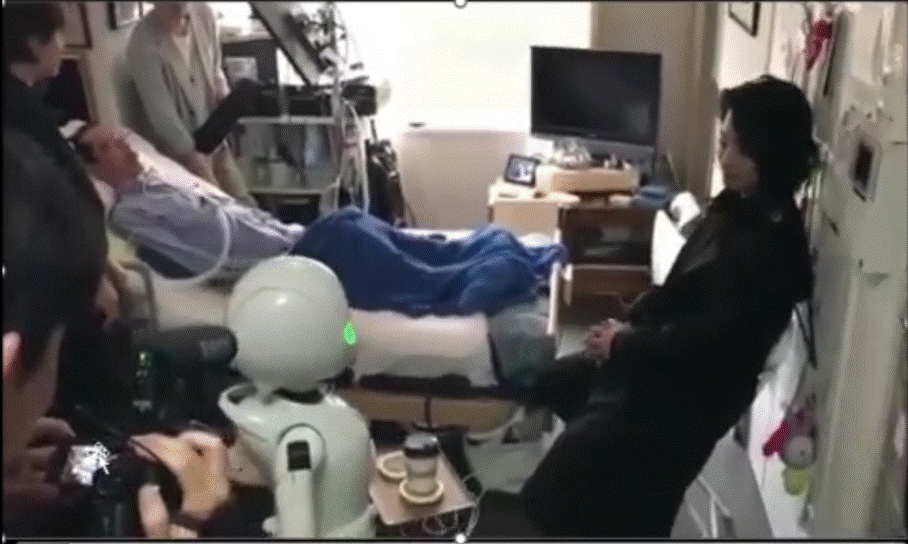
I think it is a hopeless state to be told, ‘You are going to be bedridden forever in the future if you don’t do what you are doing now. But technology will allow you to care for yourself.
The other thing I would like to talk about is the change in the way people around you treat you. In our café, you are not a person with a disability, but a café worker. I often say that one’s position makes one a person, but I also believe that the way one is treated also makes one a person. A typical example I often introduce is the case of a girl named Yurina. She was a five-year-old girl who could not move her arms and legs nearly at all. She could not speak, and we were not even sure if she understood. However, we built her a wheelchair that she could ride around in with an entire wheelchair that she could run around in with eye input, and for the first time in her life she was able to run after her mother. Seeing her running around, the adults around her began to think about giving her a better education. She graduated from elementary school in the spring of 2025 and grew up to be a space-faring girl. She now often rents out the “alter-ego robot café” and holds events there. (▲Photo 13▲)
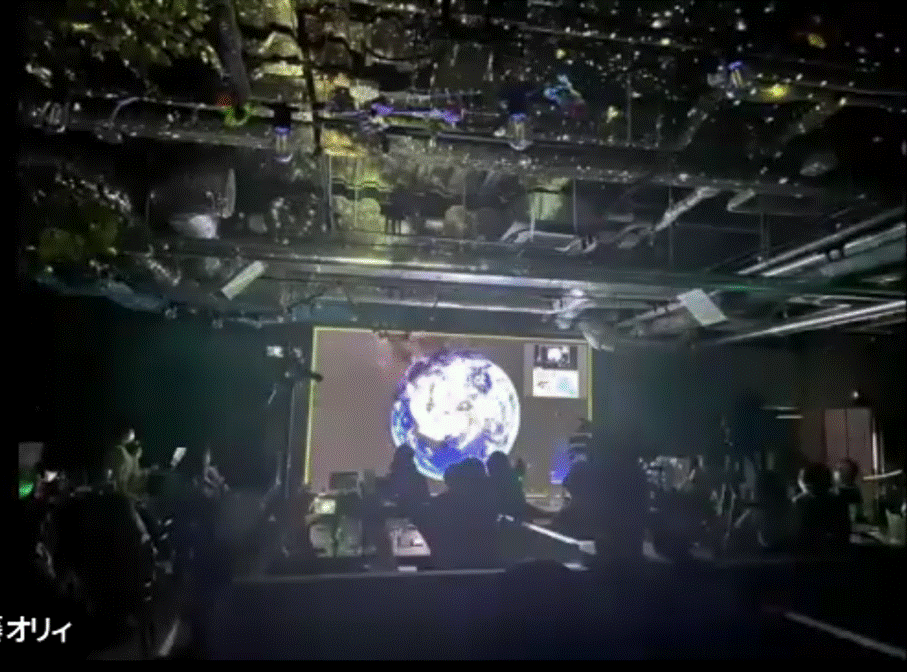
He likes Uranus, saying, ‘I like Uranus because it is the only planet in the solar system with its axis tilted 90 degrees and it is a sleeper like myself. She recently passed the second level of the Astronomy and Space Exam. She can’t speak, but she is able to do these things because of technology or because of the way she is treated by the people around her with different opportunities,” he says.
Ishido: “Until now, these technologies have often been described in terms of physical expansion. In reality, however, I believe that it is also an extension of the mind, or a device for expressing the mind outwardly. That is why I feel that this kind of technology draws out the inner will and creative impulse that says, ‘I want to do this more,’ or ‘I want to try that,'” he said.
Mr. Ory: “There is the idea of ‘I want to do this, then what should I do?’ There is also the idea of ‘This is something that came up, would you like to try it? I want to try it!’ I think there is an order of “I want to do it! I want technology to play a role in that. I am interested not in how technology will evolve, but how it will motivate people and what kind of motivation it will generate.
Ishido: “A very good positive spiral is being created, isn’t it? The idea of “I wish there was something like this” gives birth to technology, and the existence of that technology gives birth to new ideas of “I wish there was something like this”. I felt that this cycle of creation was wonderful.
By the way, the “alter-ego robot café” is also being developed overseas. Are there any differences in the way these technologies and ideas are received in Japan and overseas?
Mr. Ory: “There are differences from country to country. In Europe, we conducted a six-month experiment in Denmark. The way it is perceived is very different. For example, I think Japan is definitely an AI- and robot-friendly country; AI is also viewed positively in Japan. It is fun and exciting to see it being automated. On the other hand, there are surprisingly many countries and people who have a strong impression that automation itself, or robots, will take away their jobs.
In this context, I believe that the reason our “alter ego robot café” has been accepted overseas is not because it is an AI, but because, as in the example of Yurina mentioned earlier, there are people operating it, it is an option for how their lives will change, and also because it is a very I believe this is because of the fact that it has become a positively human-centered technology, etc. I have the strong impression that there are many people here who agree with me,” he said.
Ishido: “I think the feature and attraction is that although they look like robots, there is a human being behind them. Each person’s story is behind them, and the fact that we can catch a glimpse of that story is probably what leads to the praise you mentioned at the beginning in the comments at the café, where you praised the customer service by name, saying that the service provided by whom was good. I feel that this is exactly how heart-to-heart communication is created as a “face to face” presence. I felt that there is a warm world out there where one’s image and thoughts of the person naturally come to mind in one’s mind.
Finally, could you say a few words about what you would like to try in the future and what new challenges you would like to take on in the future?”.
Mr. Ory: “So far I have talked about creating another body so that we will be able to live the same way we do now in the future when we will no longer be able to move our bodies. I have made another interesting discovery. Many of the people who work in our café are very shy when you meet them in the flesh, but with this ‘OriHime’ they become a different person. Another strange thing about our café is that the “OriHime Pilots” stay at their seats for a while after taking orders. In a normal restaurant, he would leave immediately after taking your order and go to bring you your food. However, at the alter ego robot café, the “OriHime pilot” stays for 20 to 30 minutes. We didn’t do that at first, but when we experimented with it, we have never had a customer say, ‘I don’t like the waiter being in my seat all the time. We have experimented with over 100,000 cases so far, and not once.
Rather, it is a state of ‘I’ll come back again because the conversation with the waiter was so interesting. If a live waiter worked part-time at an izakaya and talked for 20 minutes after taking an order, you would think he would say, ‘What the heck is that guy? I think this is because the waitstaff maintains a distance from the customers, which is not possible in the flesh, and this makes it easier to have a conversation with them. I think we can make further improvements in this area.
Ishido: “In relationships between people, we are sometimes too conscious of the distance between us and hesitate to go too far. However, it would be very interesting if this kind of medium can be a catalyst for softly crossing that barrier. I feel that this could lead to the birth of new ways of communication and new forms of human relationships.
Mr. Ory: “My research is about reducing loneliness, so it’s not just about being physically challenged. There are only so many people we can meet in our lives, and the odds of meeting our super destiny are not that great. So I would like to continue my research on communication using this robot as an interface and medium for building relationships with humans.
Ishido: “Today we heard a very wide range of stories, and once again I felt the kindness of Mr. Ory, who is deeply attuned to the hearts of people. The word ‘people-centered’ is not just a philosophy, but is actually embodied by being close to people’s feelings and pains. And as a result of her challenge, she is blowing a new wind into the existing social norms, systems, and values, leading to the realization of a society that is easier for more people to live in. I have been strongly impressed by this attitude for some time, and today, I was able to reaffirm my sincere respect for it.
I myself would love to experience “NIN_NIN”. I sincerely look forward to its early mass production and further development in the future.
Mr. Ory: “We are not being nice, we are just making what we want. Please use “NIN_NIN” and “OriHime” and come visit us at the café.


